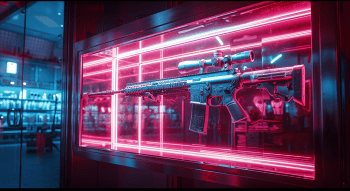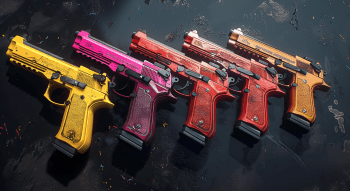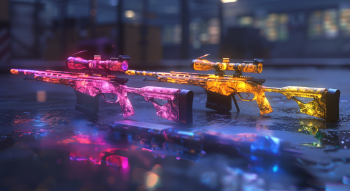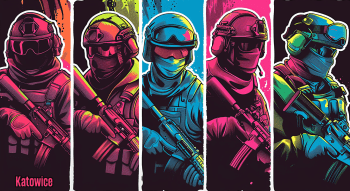The Complete CS2 Economy Guide
Contents

With the introduction of CS2 and its MR12 system, resource management has become even more crucial than it was before. Not only did the fresh format force players and teams of all skill levels to reconsider their economic strategies, but it also introduced entirely new tactics and approaches that were previously impossible in the CSGO economy.
Without understanding these changes, you will be at a massive disadvantage. Even players familiar with the franchise may struggle to grasp the new CS economy. In this CS2 buy guide, we will explore the core concepts of the game’s updated economy to make onboarding easier for both new and returning players.
Understanding CS Economy
Let’s start with breaking down the basics: what the CS2 economy is, how it impacts the game, and how it is different from CS:GO.
What is the CS2 Economy?
On a basic level, the CS economy is a set of individual and team-level decisions regarding the use of resources — money, weapons, and utilities — to gain an edge over the enemy. This strategic element of CS includes things like calculated investments, sacrifices, and manipulations aimed at strengthening your own financial position and disrupting the opponent’s flow. Mastering it is a natural way of getting better at CS2.
How the Economy Impacts Gameplay and Strategy
CS follows a time-proven formula: to win, one team must plant a bomb or eliminate the enemy team, while the other team must defend the objective, fully eliminate the opposing side, or defuse the bomb. The economic aspect of the game determines which weapons and equipment can players bring each round. The better your team’s economy is, the less sweaty your job will be: T-side players won’t have an easy time progressing on the map without proper utilities and guns, while underequipped CTs will similarly struggle to disrupt their opponents’ plans.
Key Differences From CS:GO Economy
How does the CS2 economy work compared to CS:GO? Let’s see what surprises Valve had in store for the game’s second version.
MR12
First and foremost, the format of competitive matches has changed. Previously, it was MR15 (till 16 wins); now, it’s MR12 (till 13 wins). As the game became shorter, economic decisions made every round became that much more important. The most obvious example is pistol rounds and conversions — the new CS2 economy chart confirms that winning both of these increases your chances of securing a match win by 3-5% more compared to CS:GO.
Shorter matches also mean fewer recovery opportunities, making the game significantly more dynamic. Teams are far more willing to spend money than in CS:GO. As a result, force buy rounds are very common and very effective.
Refund System
CS2 added an all-new feature to the game’s economy — refunds. Anything you buy can be refunded during the buytime. What this means in practice is that now you can adjust your tactic on the go. Sometimes, the right call comes to mind with the last ticks of freeze time, and the ability to cancel your initial purchase and rebuy is more significant than it may seem.
Price Changes
Veteran CS players know that managing your team’s economy has always been harder when playing as counter-terrorists — the AWP is essential, regardless of the map, rifles and some utilities are more expensive, and a defuse kit is a must. Besides, CS2 was extremely T-sided during the first months after the release due to the peekers’ advantage.
So, Valve reduced the prices for some of the essential CT items, including the M4A4 and molly. At first, this 100–200 buck difference seemed no more than a cosmetic shift. However, in MR12, with its force buys, a single rifle supported by Deagles or Scouts can make a huge difference. Another change is that if the CTs successfully defuse the bomb, the Ts will receive $600 for their efforts. All of these changes are well-thought-out and go a long way to make the game more balanced.
Common CS2 Economy Strategies
Now, let’s talk about round types. There are plenty, but all of them follow a simple logic — you have to win the initial “economy game” as soon as possible. Despite the common misconception originating from older Counter-Strike games, it’s not as simple as “You eco until you have a full buy.” In CS2, your team’s strategy has to be much more versatile.

Full Eco/Eco
Depending on the current loss bonus, teams can opt for full eco rounds to ensure a full buy in the next round. In CS2, the usual timing for a full eco is after losing the pistol and the following force buy. This way, the team will be fully packed in round 4.
Full eco isn't necessarily a "don’t-buy-anything" type of round. For example, expensive pistols can give players at least some chances in firefights, and even minimal utility allows you to pull off some cheeky plays. For example, you can fake a cross to B on the CT side of Dust 2 or buy a couple of smokes to make it look like your team is not on eco.
Impact on the economy: While losing these rounds is the most likely outcome, winning an eco will be a huge boost to your team’s economy and fighting spirit. If you win with 2+ players surviving, your team will have plenty of resources for at least 2 following rounds.
Force Buy
Forces are pervasive in CS2. The typical situation for this type of buy is when you don’t have enough money for a full buy-in in the next round, even if you opt for a complete eco now. The best decision in such cases is to go for the best buy for whatever little money you possess and try to make the most out of it. In the worst-case scenario, you will have the loss bonus built up, allowing you to go for a complete eco and aim for a full buy-in in the next two rounds. In the best-case scenario, you win with fewer weapons and utility, completely disrupting the opposing team’s strategy. Speaking of which, sometimes you force buying to hurt the enemy’s economy rather than to boost your own.
If you know that the “economy game” is still going on and no one has the edge just yet, you can go for a force even if you lost the previous round (especially if you managed to make it costly for the enemies). Even in pro games, these back-and-forth low-buy exchanges can go on for a good part of the game.
Impact on the economy: Regardless of the outcome, after a force buy, you don’t have the luxury of a loss bonus. Therefore, losing it will put you in eco territory. Besides, even if you manage to claim a victory, you’ll have to maximize its impact by saving as many players as possible and collecting/upgrading guns.
Anti-Eco / Farming
Next up are anti-ecos. As the name suggests, these are the rounds you want to win with minimal casualties while farming as much money as possible. That is, one or two players can opt to farm guns at the start or end of the round.
While playing as CTs, ensure you have anti-rush nades and opt for long-range fights with your stronger guns. On the T side, don’t forget to buy utilities to clear dangerous close-range angles, move as a pack, and avoid rushing.
Impact on the economy: These rounds are a must-win. Even if you take anti-eco with 2 or more casualties, it is likely a failure, as your enemies will gain a significant economic advantage.
Semi-Buy
This is a strategy for when your team doesn’t have enough funds for a full buy, but can still afford something more expensive than a cheap pistol. In such cases, it’ll be a good idea to focus on cheap rifles (FAMAS or Galil), SMGs, and essential utilities (smokes, defuse kits). The beauty of these rounds is that you can go all-in without worrying about the next round's economy.
Impact on the economy: Semi-buy is a type of upgraded eco and follows a similar logic: win and receive a significant boost to the economy and morale; lose and plan the next full buy.
Full Buy
Full buy is the perfect scenario where every player can get their main rifle, and your setups are backed by strong utilities. Note that it’s still unadvisable to buy a full-team set of defuse kits even if you have enough money to do so. It’s better by far to have 2–3, preferably on your site anchors. This way, you will have kits available close to the bomb even if these players die, and your economy won’t suffer as much.
Impact on the economy: It largely depends on the game in question. Full buys represent your best odds of winning, but even if you lose a lot of guns or let enemies save theirs, it can be a net positive as long as you don't lose the round. However, losing full buys hurts, especially if you can’t afford full gear for the next round. If you lose a full buy, the enemies will get a huge boost, allowing them to win the next 2–3 rounds without much effort.
Money Mechanics: How Players Earn and Lose Money
Now, let’s discuss the ways you can earn money in CS.
Round Win Rewards
The main source of income in CS2 is round-win rewards. CTs can win by defusing the bomb ($3,500), eliminating all T’s ($3,250), or by preventing a bomb plant ($3,250). Note that when the bomb is defused, the player who did it gets an extra $300.
For the T side, winning a round requires either bombing the target ($3,500) or killing all CTs ($3,250). The player who plants a bomb gets an extra $300, as well.
CS2 Loss Bonus
Speaking of loss bonuses, it's a comeback mechanic created to balance the game — whenever you lose several rounds in a row (up to 4), you get bonus cash.
Round loss count | Loss bonus |
1 | $1,400 (no bonus, just default money for losing) |
2 | $1,900 |
3 | $2,400 |
4 | $2,900 |
5 | $3,400 (max) |
CS2 has also improved the interface in terms of players’ statistics. Now, the loss bonus your team has accumulated is displayed on-screen.

Kill Rewards by Weapon Type
CS2 kill rewards depend on the weapon you’ve used, with knife kills granting the most money. Also, there are some SMGs and shotguns with relatively high rewards. Usually, you should go for a “farming” weapon when you are sure that your opponents are on an eco or a low buy.
Weapon | Kill bonus |
Zeus x27 | $100 |
AWP | $100 |
Pistols | $300 |
P90 | $300 |
Assault Rifles (except AWP) | $300 |
Machine Guns | $300 |
Submachine Guns (except P90) | $600 |
XM1014 | $600 |
Shotguns (except XM1014) | $900 |
Grenades | $900 |
Knives | $1,500 |
Penalties and Deductions
Interestingly, if you die as a terrorist after the end of the round without planting the bomb, you’ll get $0 in the next round. So, if your team is losing, and you don’t have any valuable guns, it may be a good idea to die before the round timer ends.
Pro-Level Economic Strategies
Now, let’s review a couple of examples of the pros’ approach to economy in CS2. Usually, high-level play is less about adhering to pre-planned economic strategies and more about your ability to adapt on the go. Still, our economy guide in CS2 includes a couple of generally useful things we’ve gleaned from the way the pros handle this aspect of the game.
Economy Control on T and CT Sides
Pro players rarely follow the same patterns for the defense and offense. For instance, after losing a pistol round with the bomb plant as Ts, most pro teams will opt for a full buy. The logic behind this move is simple – even though CTs won the round, T-side weapons are cheaper and are easily on par with the ones that CTs will buy after defusing the bomb.
Force buys are quite common for the CT side after losing a pistol round. The logic here is to try to break the Ts’ economy while they can’t afford full AKs. Even if the plan fails, CTs will build a loss bonus. It will be crucial for buying M4s and an AWP to fight the full AK T team.
Double AWP
Sometimes, things don’t go according to plan, and you need a quick and massive change to make things work. That’s when the double CT AWP setup comes in handy.
All pro teams have their main sniper — the AWP guy (ZywOo for Vitality, sh1ro for Spirit, 910 for Mongolz, etc.). However, there’s usually at least one other team member proficient in using this rifle (ropz for Vitality, donk or magixx for Spirit, senzu for Mongolz). Double AWP can catch your enemies off guard at any point in the game, especially if both AWPers stay mobile.
Glass Canon
AWP is very powerful. Sometimes, players go for a single sniper rifle without any utilities, supporting guns, or even Kevlar and still win rounds. Casters usually call going for an AWP without armor Glass Canon.
Here’s a crazy video that has both double AWP and glass canon buys on CT Mirage.
CS2 Economy Tips
Here are some more insights to finish our CS2 economy guide. Let’s break down a couple of generally useful ideas.
Communication and Planning
Building a sustainable economy is possible only via team effort. So, even if you’re playing solo, try talking with your team. You may start with something simple, like calling an eco when you see that the team needs it.
Importance of Drops and Resource Sharing
Another thing to keep in mind is that even when you are winning, somebody on your team still dies, so the cash spread is uneven. Make sure to check your teammates’ money and drop guns, pistols, and flashes for those who cannot afford them. CS2 is a team game, and a bit of sharing can easily win you entire matches.
Reading the Enemy’s Economic State
Understanding the economy of the opposing team is just as important as handling your own; depending on their money, you can predict their actions. It’s a part of a bigger thing called game sense — your ability to predict the flow of a round or even a match.
Conclusion
That’s it for today’s CSGO economy guide. It might seem like a lot of info, but it should never be underestimated. Understanding money in CS2 enough to adjust your strategy on the run when the situation calls for it is the only way to improve your game.





















